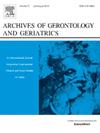养老院COVID-19感染和死亡的累积劣势:所有权地位和位置的影响
IF 3.8
3区 医学
Q2 GERIATRICS & GERONTOLOGY
引用次数: 0
摘要
目的:在安老院安置之前,在安老院生活中积累的不利因素可能会在安老院内加剧,潜在地放大这些不利因素对安老院预后的影响。本研究考察了养老院的位置和所有权在多大程度上区分了结果轨迹和对瞬时威胁影响的易感性,瞬时威胁是在特定时期可能影响COVID-19结果的时变压力源。方法“COVID-19养老院数据”提供了2020年6月至2021年1月期间来自11088家养老院的COVID-19感染和死亡的每周报告。养老院按营利性与非营利性所有权以及农村与城市位置进行分类。短期威胁包括养老院和县级COVID-19感染率以及人员短缺。多水平多项式负二项回归嵌套养老院内的每周观察,并测试养老院因素对轨迹和瞬间威胁的影响。结果营利性疗养院的新型冠状病毒感染/死亡率高于非营利性疗养院,且随着时间的推移,差异越来越大。在基线时,农村养老院的COVID-19感染/死亡率低于城市养老院,但随着时间的推移,农村养老院的感染率高于城市养老院。每周县级新冠肺炎感染对农村养老院的影响更大。然而,在营利性和农村养老院,养老院COVID-19感染的每周变化对死亡的影响较小。结论本研究揭示了养老院在COVID-19感染和死亡方面的累积劣势,表明解决养老院内COVID-19防控不平等问题的重要性。本文章由计算机程序翻译,如有差异,请以英文原文为准。
Cumulative disadvantages in nursing home COVID-19 infections and deaths: implications of ownership status and location
Objective
Disadvantages accumulated over the span of residents’ lives before nursing home placement can compound within nursing homes, potentially amplifying the effects of those disadvantages on resident outcomes. This study examined the extent to which nursing home location and ownership differentiated the outcome trajectories and susceptibility to the impact of momentary threats, the time-varying stressors that can influence COVID-19 outcomes during a specific period.
Methods
The COVID-19 Nursing Home Data provided weekly reports of COVID-19 infections and deaths from June 2020 to January 2021 from 11,088 nursing homes. Nursing homes were categorized by for-profit vs. not-for-profit ownership and rural vs. urban location. Momentary threats included the nursing home and county-level COVID-19 infection rate and staff shortage. Multilevel multinomial negative binomial regression nested weekly observations within nursing homes and tested the impact of nursing home factors on the trajectory and momentary threats.
Results
COVID-19 infection/mortality rates were higher in for-profit than in non-profit nursing homes, showing worsening disparities over time. At baseline, rural nursing homes had lower COVID-19 infection/mortality rates than urban nursing homes, but rural nursing homes reported higher rates than urban nursing homes over time. Weekly county-level COVID-19 infection had stronger impacts in rural nursing homes. However, the impact of weekly variation in nursing home COVID-19 infections on deaths was smaller in for-profit and rural nursing homes.
Conclusion
This study revealed cumulative disadvantage of nursing home characteristics in COVID-19 infections and deaths, implying the importance of addressing inequalities in prevention and control of COVID-19 within nursing homes.
求助全文
通过发布文献求助,成功后即可免费获取论文全文。
去求助
来源期刊
CiteScore
7.30
自引率
5.00%
发文量
198
审稿时长
16 days
期刊介绍:
Archives of Gerontology and Geriatrics provides a medium for the publication of papers from the fields of experimental gerontology and clinical and social geriatrics. The principal aim of the journal is to facilitate the exchange of information between specialists in these three fields of gerontological research. Experimental papers dealing with the basic mechanisms of aging at molecular, cellular, tissue or organ levels will be published.
Clinical papers will be accepted if they provide sufficiently new information or are of fundamental importance for the knowledge of human aging. Purely descriptive clinical papers will be accepted only if the results permit further interpretation. Papers dealing with anti-aging pharmacological preparations in humans are welcome. Papers on the social aspects of geriatrics will be accepted if they are of general interest regarding the epidemiology of aging and the efficiency and working methods of the social organizations for the health care of the elderly.

 求助内容:
求助内容: 应助结果提醒方式:
应助结果提醒方式:


